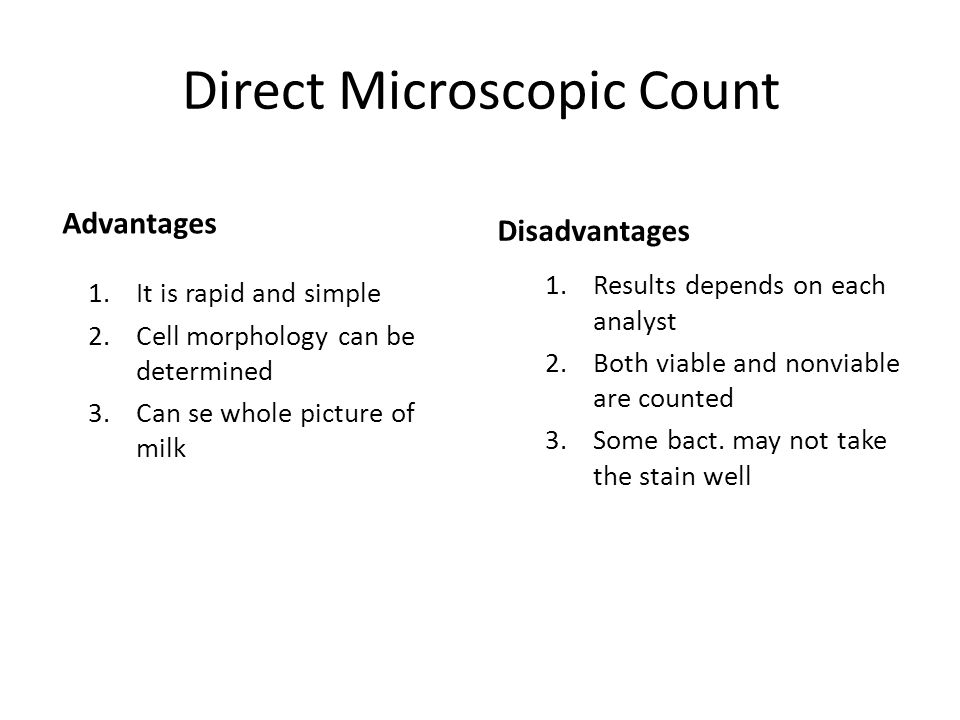
What Are Some Advantages And Disadvantages Of The Serial Dilution Agar Plate Te
Aug 22, 2010 Serial dilutions & 'spread plate technique'? If you were to directly take a given serial dilution and do a count under a microscope what would be the advantages and disadvantages of this method versus carrying out the serial dilution-agar plate procedure to count the number of 'cells'? Mar 02, 2007 Best Answer: The variance in colonies produced. You get the colony size you need to work with. You do not want your plates to ' lawn ', do you?
Here's a paragraph about the molds that may help to infer the reason of the advantages during observation of mold colonies: 'Because the structural components of molds are very delicate, even simple handling with an inoculating loop may result in mechanical disruption of their components.The followi ng culture technique es used to to avoid this disruption. After culturing, molds spores are deposited in the surface of the agar and incubated in a moist chamber at room temperature. Direct microscopic observation is then possible without fear of disruption or damage to the anatomical components'.
It may be more beneficial in this aspect: allowing a full and healthy growth of the mold, that is, with its complete structure, then to be able to proceed to look through the microscope maybe it form, type of spore,sporangia or mycelium. In short, ensure that the mold to grow properly. Maybe it's not what you exactly were looking for but it could help you! Second Year of Microbiology bachelor's degree (University Of Puerto Rico in Arecibo) Paragraph taken of Capuccino/Sherman Microbiology. A laboratory Manual.Eight Edition.
The following are some advantages of an agar plate verses a slant tube: 1. Surface area- An agar plate has a much larger surface area: a.
Easier to isolate individual colonies using the streak-plate method. Evaluate the colony shape, margin and elevation.
Can grow a larger number of ce lls. Growth- An agar plate allows you to quantify the number of colonies on an agar plate, provided it is within the 30-300 range. Whereas the slant tube cannot quantify growth but only describes growth as none, slight, moderate, or large.
Overview Source: Laboratories of Dr. Ian Pepper and Dr. Charles Gerba - Arizona University Demonstrating Authors: Bradley Schmitz and Luisa Ikner Surface soils are a heterogeneous mixture of inorganic and organic particles that combine together to form secondary aggregates. B2k greatest hits rarities. Within and between the aggregates are voids or pores that visually contain both air and water. These conditions create an ideal ecosystem for bacteria, so all soils contain vast populations of bacteria, usually over 1 million per gram of soil.
Bacteria are the simplest of microorganisms, known as prokaryotes. Within this prokaryotic group, there are the filamentous microbes known as actinomycetes. Actinomycetes are actually bacteria, but they are frequently considered to be a unique group within the classification of bacteria because of their filamentous structure, which consists of multiple cells strung together to form hyphae. This experiment uses glycerol case media that select for actinomycete colonies, during dilution and plating. Typically, actinomycetes are approximately 10% of the total bacterial population. Bacteria and actinomycetes are found in every environment on Earth, but the abundance and diversity of these microbes in soil is unparalleled.
These microbes are also essential for human life and affect what people eat, drink, breathe, or touch. Malayalam christian drama script pdf. In addition, there are bacterial species that can infect people and cause disease, and there are bacteria that can produce natural products capable of healing people. Actinomycetes are particularly important for producing antibiotics, such as streptomycin.